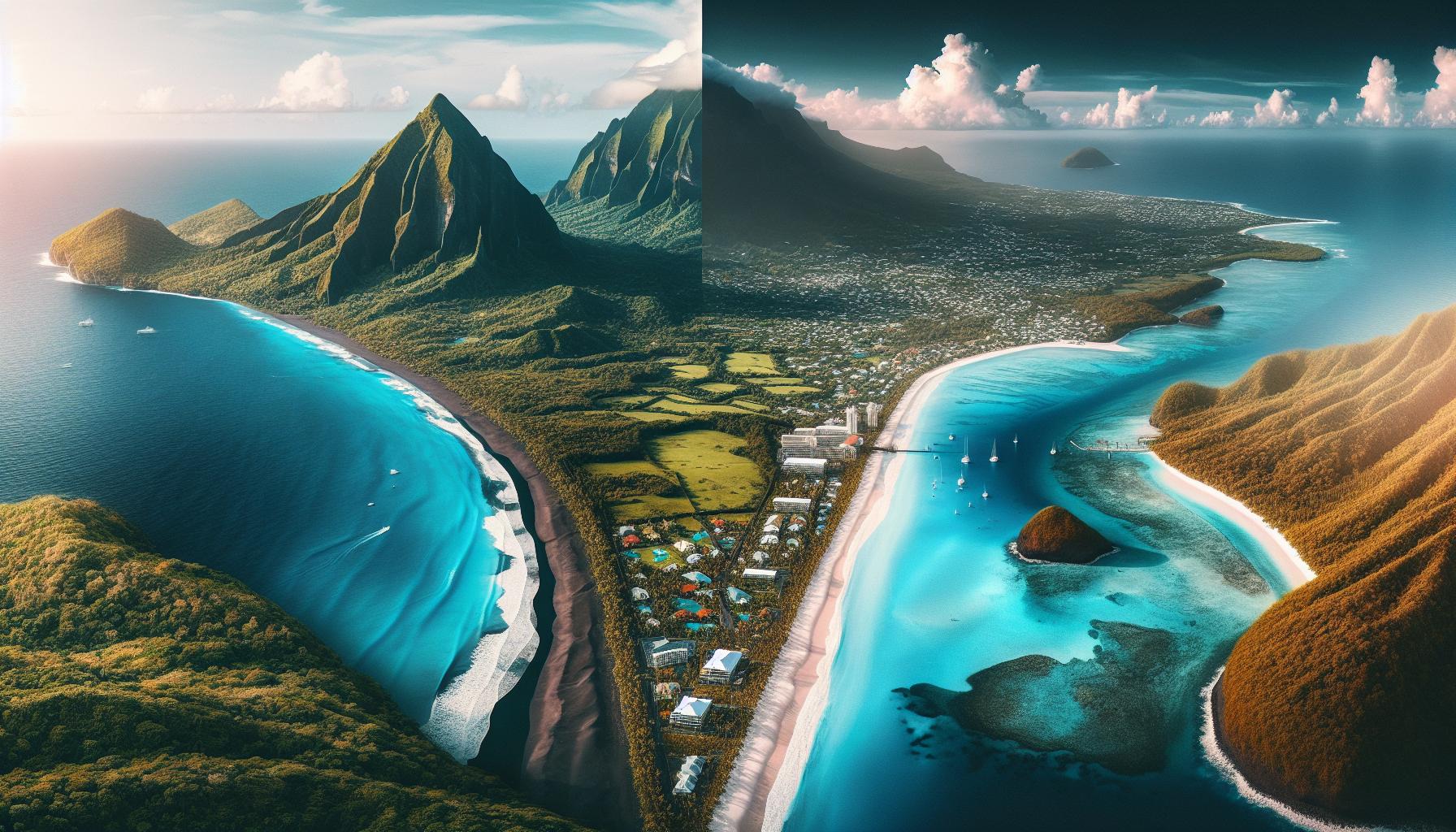Phone:
(701)814-6992
Physical address:
6296 Donnelly Plaza
Ratkeville, Bahamas.

Choosing between St. Lucia and Turks and Caicos feels like picking between two slices of paradise – each with its own special flavor of Caribbean bliss. While both destinations offer stunning beaches and crystal-clear waters, they couldn’t be more different in their vacation vibes.
St. Lucia dazzles visitors with its dramatic Piton mountains, lush rainforests, and romantic atmosphere that’s perfect for honeymooners. Meanwhile, Turks and Caicos boasts some of the world’s most pristine beaches, with Grace Bay consistently ranking among the planet’s finest stretches of sand. From adventure seekers to beach bums, these tropical havens serve up distinct experiences that’ll have travelers dreaming of their next island escape.
St. Lucia and Turks & Caicos occupy distinct locations in the Caribbean Sea, each with unique geographical characteristics that shape their visitor experiences.
St. Lucia sits in the Eastern Caribbean, positioned between Martinique and St. Vincent at 13.9094° N, 60.9789° W. Turks & Caicos lies in the Northern Caribbean, southeast of the Bahamas at 21.6940° N, 71.7979° W. The average temperature in St. Lucia ranges from 75°F to 85°F year-round with higher humidity levels due to its rainforest climate. Turks & Caicos experiences temperatures between 80°F to 90°F with lower humidity and receives only 21 inches of annual rainfall.
| Location | Average Temperature | Annual Rainfall |
|---|---|---|
| St. Lucia | 75-85°F | 65-75 inches |
| Turks & Caicos | 80-90°F | 21 inches |
St. Lucia encompasses 238 square miles of dramatic volcanic terrain dominated by the iconic Piton mountains rising 2,619 feet above sea level. Turks & Caicos spreads across 366 square miles, consisting of 40 low-lying coral islands with the highest elevation reaching only 163 feet. St. Lucia features dense rainforests, waterfalls, black sand beaches from volcanic activity. Turks & Caicos presents flat coral formations, extensive barrier reefs, white sand beaches stretching 230 miles.
| Island | Total Area | Highest Elevation | Number of Islands |
|---|---|---|---|
| St. Lucia | 238 sq mi | 2,619 ft | 1 |
| Turks & Caicos | 366 sq mi | 163 ft | 40 |

The contrasting landscapes of St. Lucia and Turks & Caicos create distinctive tropical experiences. Each destination showcases unique natural features that attract different types of travelers.
St. Lucia’s dramatic terrain emerges from its volcanic origins, dominated by the UNESCO-listed Piton Mountains rising 2,619 feet above sea level. The island’s western coast features secluded coves with dark sand beaches, formed by volcanic minerals. Dense rainforest covers 19,000 acres of the interior, offering 29 miles of hiking trails through exotic flora. The island’s topography creates multiple microclimates, supporting diverse ecosystems from coastal mangroves to mountain cloud forests. Natural hot springs bubble up near Soufrière, producing therapeutic sulfur pools at temperatures reaching 110°F.
Grace Bay Beach anchors Turks & Caicos’ reputation with 12 miles of powder-white sand shoreline. The archipelago boasts 230 miles of white sand beaches, protected by the world’s third-largest coral reef system. Crystal-clear waters maintain visibility up to 200 feet deep, revealing vibrant coral gardens. The shallow Caicos Banks spans 6,140 square kilometers of turquoise waters, creating ideal conditions for wade fishing. Coastal areas feature natural limestone formations including unique rock pools at Mudjin Harbor on Middle Caicos. The barrier reef protects 340 square miles of pristine marine habitat.
Both St. Lucia and Turks and Caicos offer diverse lodging experiences from luxury resorts to boutique hotels. Each destination showcases unique architectural styles that complement their distinct landscapes.
St. Lucia’s luxury resorts integrate seamlessly into the mountainous landscape, with properties like Jade Mountain offering open-air suites facing the Pitons. Ladera Resort features 32 suites with missing fourth walls, creating an immersive tropical experience. Top accommodations include Sugar Beach, A Viceroy Resort, nestled between the Piton mountains.
Turks and Caicos luxury properties focus on beachfront locations, particularly along Grace Bay. COMO Parrot Cay occupies its own private island with 1,000 acres of exclusive space. Grace Bay Club pioneered luxury tourism with oceanfront infinity pools. Amanyara presents 38 timber-shingled pavilions surrounded by marine reserves.
| Accommodation Type | St. Lucia (USD) | Turks and Caicos (USD) |
|---|---|---|
| Luxury Resorts | 800-3,000/night | 1,200-5,000/night |
| Boutique Hotels | 300-700/night | 400-900/night |
| Villa Rentals | 500-2,500/night | 800-4,000/night |
St. Lucia offers more varied price points across its accommodation spectrum. Five-star resorts in Turks and Caicos command premium rates due to limited room inventory. Boutique properties in St. Lucia provide mountain or ocean views at moderate prices. Private villa rentals in Turks and Caicos trend higher because of beachfront locations.
Both destinations offer distinct recreational experiences shaped by their unique landscapes. St. Lucia specializes in adventure activities amid its volcanic terrain while Turks and Caicos excels in water-based recreation.
Turks and Caicos features 230 miles of vibrant coral reefs with visibility extending up to 100 feet underwater. Divers explore 85 dive sites including the dramatic walls off Grand Turk plunging 7,000 feet deep. Snorkelers encounter spotted eagle rays, sea turtles, reef sharks in the clear waters of Smith’s Reef and Bight Reef. St. Lucia’s diving focuses on 22 sites near Soufrière Bay where volcanic formations create dramatic underwater topography. Key spots include the Lesleen M wreck site teeming with tropical fish species. Both islands offer kayaking rentals while Turks and Caicos specializes in kiteboarding at Long Bay Beach from December through April when trade winds peak.
St. Lucia immerses visitors in Caribbean culture through its Friday night street parties in Gros Islet featuring local food trucks serving grilled lobster and rum punch. Guided rainforest tours explore cocoa plantations where visitors learn traditional chocolate-making methods. The Castries Market displays local crafts including hand-woven baskets and spice vendors. Turks and Caicos highlights its maritime heritage at the Grand Turk Lighthouse built in 1852. Local guides lead visitors through the historical Cheshire Hall plantation ruins on Providenciales while Thursday night’s Island Fish Fry celebrates local cuisine with live ripsaw music performances.
The journey to both Caribbean destinations requires different travel considerations. Each island’s accessibility impacts vacation planning from flight arrangements to local transportation options.
Direct flights to St. Lucia’s Hewanorra International Airport (UVF) depart from major U.S. cities including Miami, New York, Atlanta, Charlotte, Boston, and Chicago. American Airlines, Delta, United, and JetBlue operate these routes with average flight times of 4-6 hours from the East Coast.
Turks and Caicos’ Providenciales International Airport (PLS) connects to similar U.S. hubs through American Airlines, Delta, United, and JetBlue. Flight durations from East Coast cities average 3-4 hours, offering more frequent daily connections compared to St. Lucia.
St. Lucia’s mountainous terrain creates winding roads that extend travel times between destinations. Taxis operate on fixed rates between zones, while rental cars require a temporary driving permit ($20) for left-side driving. Water taxis connect popular beaches and resorts along the western coast.
Turks and Caicos features flat, well-maintained roads on Providenciales. Rental cars drive on the left side, with scooters and bicycles available for shorter trips. Inter-island transportation includes domestic flights on Caicos Express Airways and private boat charters. Taxis use standard meters or zone-based pricing for tourist areas.
The optimal timing for visiting St. Lucia and Turks and Caicos depends on weather patterns seasonal events. Each destination offers distinct advantages during specific months of the year.
St. Lucia experiences its peak season from December through April, with average temperatures of 82°F and minimal rainfall. Tourism peaks in Turks and Caicos between December and March, featuring daytime temperatures around 85°F with low humidity. Room rates increase by 30-40% during these high seasons in both destinations. St. Lucia’s shoulder season runs from May to June, offering reduced rates and comfortable temperatures averaging 84°F. Turks and Caicos sees fewer visitors from April to November, presenting opportunities for discounted accommodations up to 40% off peak prices.
| Season | St. Lucia | Turks and Caicos |
|---|---|---|
| Peak | Dec-Apr | Dec-Mar |
| Temperature | 82°F | 85°F |
| Rate Increase | 40% | 35% |
| Shoulder | May-Jun | Apr-Nov |
The Atlantic hurricane season affects both destinations from June 1 to November 30. Turks and Caicos faces a higher risk of direct hurricane impacts due to its location in the hurricane belt, experiencing an average of one major storm every 7 years. St. Lucia sits outside the primary hurricane path, recording only 14 direct hits in the past 50 years. September presents the highest risk for both locations, with an 18% chance of tropical storm activity. Most resorts offer hurricane protection policies, providing full refunds or rescheduling options for weather-related cancellations.
| Hurricane Statistics | St. Lucia | Turks and Caicos |
|---|---|---|
| Season Duration | Jun 1-Nov 30 | Jun 1-Nov 30 |
| Direct Hits (50 yrs) | 14 | 7 |
| Peak Risk Month | September | September |
| Storm Probability | 8% | 18% |
A detailed cost analysis reveals significant price variations between St. Lucia and Turks and Caicos. The overall vacation expenses differ based on accommodation choices, dining options, and activity selections.
Turks and Caicos commands higher accommodation rates, with luxury beachfront resorts averaging $800-$1,200 per night during peak season. Five-star properties like COMO Parrot Cay and Amanyara exceed $1,500 nightly. St. Lucia offers more diverse pricing options, with mid-range hotels starting at $200-$400 per night. Luxury mountain resorts like Jade Mountain range from $1,000-$2,000 nightly. Budget accommodations in St. Lucia start at $100, while Turks and Caicos’ minimum rates hover around $300 per night.
Daily dining costs in Turks and Caicos average $150-$200 per person at upscale restaurants, with casual beachfront venues ranging from $30-$50 per meal. St. Lucia’s dining expenses run 20-30% lower, with local restaurants offering meals from $15-$25. Activity pricing varies significantly: St. Lucia’s rainforest tours cost $60-$100, while volcano tours range from $90-$150. Turks and Caicos’ water activities command premium rates, with private boat charters starting at $500 for 4 hours. Snorkeling excursions cost $75-$125 per person in both destinations.
| Expense Category | St. Lucia | Turks and Caicos |
|---|---|---|
| Budget Hotels | $100-200 | $300-400 |
| Luxury Resorts | $1,000-2,000 | $800-1,500 |
| Average Meal Cost | $15-25 | $30-50 |
| Activity Prices | $60-150 | $75-500 |
Both St. Lucia and Turks and Caicos offer exceptional Caribbean experiences tailored to different traveler preferences. St. Lucia beckons adventure seekers and romance enthusiasts with its dramatic volcanic landscapes and lush rainforests while Turks and Caicos attracts beach lovers seeking pristine shores and world-class water activities.
The choice between these destinations ultimately depends on individual priorities. Travelers dreaming of mountainous views diverse ecosystems and cultural immersion will find their paradise in St. Lucia. Those yearning for powdery white beaches crystal-clear waters and luxurious beachfront living should set their sights on Turks and Caicos.
Regardless of the choice both destinations promise unforgettable Caribbean memories with their unique charm and natural beauty.